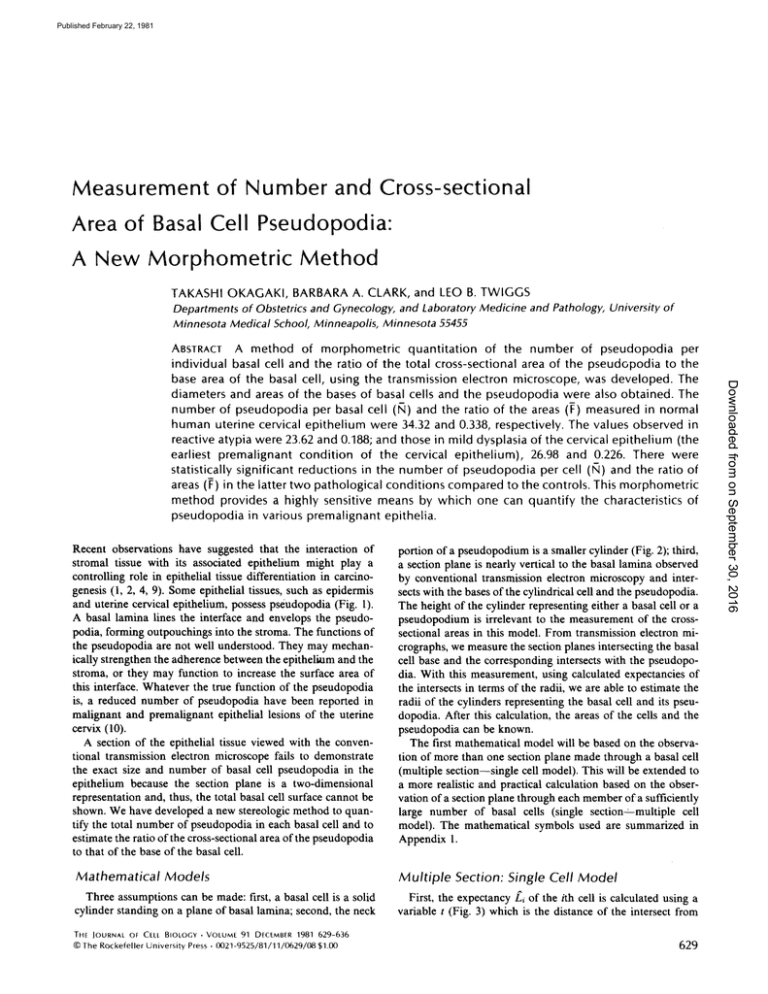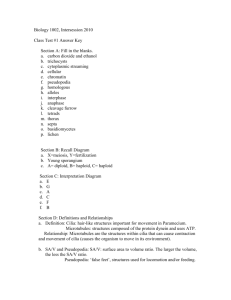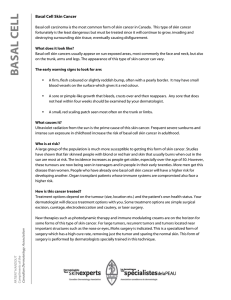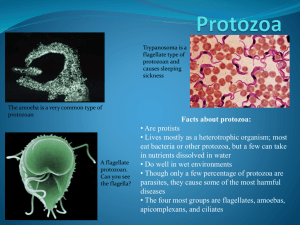Measurement of Number and Cross-sectional Area of Basal Cell
advertisement

Published February 22, 1981 Measurement of Number and Cross-sectional Area of Basal Cell Pseudopodia : A New Morphometric Method TAKASHI OKAGAKI, BARBARA A . CLARK, and LEO B. TWIGGS Departments of Obstetrics and Gynecology, and Laboratory Medicine and Pathology, University of Minnesota Medical School, Minneapolis, Minnesota 55455 A method of morphometric quantitation of the number of pseudopodia per individual basal cell and the ratio of the total cross-sectional area of the pseudopodia to the base area of the basal cell, using the transmission electron microscope, was developed . The diameters and areas of the bases of basal cells and the pseudopodia were also obtained . The number of pseudopodia per basal cell (N) and the ratio of the areas (F) measured in normal human uterine cervical epithelium were 34 .32 and 0.338, respectively . The values observed in reactive atypia were 23 .62 and 0.188; and those in mild dysplasia of the cervical epithelium (the earliest premalignant condition of the cervical epithelium), 26 .98 and 0.226 . There were statistically significant reductions in the number of pseudopodia per cell (N) and the ratio of areas (F) in the latter two pathological conditions compared to the controls . This morphometric method provides a highly sensitive means by which one can quantify the characteristics of pseudopodia in various premalignant epithelia. ABSTRACT Mathematical Models Three assumptions can be made: first, a basal cell is a solid cylinder standing on a plane of basal lamina ; second, the neck THE JOURNAL OF CELL BIOLOGY " VOLUME 91 DECEMBER 1981 629-636 ©The Rockefeller University Press - 0021-9525/81/11/0629/08 $1 .00 portion of a pseudopodium is a smaller cylinder (Fig . 2) ; third, a section plane is nearly vertical to the basal lamina observed by conventional transmission electron microscopy and intersects with the bases of the cylindrical cell and the pseudopodia . The height of the cylinder representing either a basal cell or a pseudopodium is irrelevant to the measurement of the crosssectional areas in this model. From transmission electron micrographs, we measure the section planes intersecting the basal cell base and the corresponding intersects with the pseudopodia . With this measurement, using calculated expectancies of the intersects in terms of the radii, we are able to estimate the radii of the cylinders representing the basal cell and its pseudopodia. After this calculation, the areas of the cells and the pseudopodia can be known . The first mathematical model will be based on the observation of more than one section plane made through a basal cell (multiple section-single cell model) . This will be extended to a more realistic and practical calculation based on the observation of a section plane through each member of a sufficiently large number of basal cells (single section-multiple cell model) . The mathematical symbols used are summarized in Appendix 1 . Multiple Section: Single Cell Model First, the expectancy L; of the ith cell is calculated using a variable t (Fig . 3) which is the distance of the intersect from 629 Downloaded from on September 30, 2016 Recent observations have suggested that the interaction of stromal tissue with its associated epithelium might play a controlling role in epithelial tissue differentiation in carcinogenesis (1, 2, 4, 9) . Some epithelial tissues, such as epidermis and uterine cervical epithelium, possess pseudopodia (Fig. 1) . A basal lamina lines the interface and envelops the pseudopodia, forming outpouchings into the stroma. The functions of the pseudopodia are not well understood. They may mechanically strengthen the adherence between the epithelium and the stroma, or they may function to increase the surface area of this interface . Whatever the true function of the pseudopodia is, a reduced number of pseudopodia have been reported in malignant and premalignant epithelial lesions of the uterine cervix (10) . A section of the epithelial tissue viewed with the conventional transmission electron microscope fails to demonstrate the exact size and number of basal cell pseudopodia in the epithelium because the section plane is a two-dimensional representation and, thus, the total basal cell surface cannot be shown. We have developed a new stereologic method to quantify the total number of pseudopodia in each basal cell and to estimate the ratio of the cross-sectional area of the pseudopodia to that of the base of the basal cell . Published February 22, 1981 Oblique View FIGURE 3 Schematic representation for calculation of expectancy of an intersect of the circular base of a basal cell . One also sees that the population standard deviation of Li; (the standard deviation of Li ; in an observation of infinite j), cL; Bottom View N_ (2) 4 is approximately one-third of the magnitude of Li . From Eq . 1, 4 .. (3) Similarly, the expectancy of the length of the intersect between the base of the kth pseudopodium of the ith cell lik ° 2 rik . (4) 4 a 6ik ; _ 1ik " (5) Also 77 L, and Ti obtained after observing a sufficiently large number of section planes m are the estimators of Li and li . From L i and Ti one can obtain estimators of h i, Ai, r"i , and ai : Intersect 2R i - _ Li, section plane 4 -2 Ai=_Li, 17 Stereological calculations of the base area of a basal cell and the basal area of a pseudopodium are based on the model assuming that they are cylinders with the radii R; and r'; . The lengths of the intersects of the 1th plane with the base of the cell and the base of the pseudopodium are designated with L;; and 1k respectively, where i(= 1, . . , M), j(= 1, . . . m), and k(= 1, . . , IV,) represents the numerical designations of the cells, section planes, and pseudopodia. J R; 2 630 Ri dt (8) 4-z a, -_li . (9) As defined, Ri is the number of pseudopodia in the ith cell from the observations of a finite number of sections, m . We defined li; such that 1 n ni! k -. the center of the circular base of the cell . That is R~ 2_ ri = _ li, and FIGURE 2 2 F lt;k, whereas 77 = 2 Ri . THE JOURNAL OF CELL BIOLOGY " VOLUME 91, 1981 (6 ) (1) m 1 hi = --Z ni! m ; (10) Downloaded from on September 30, 2016 Schematic representation of pseudopodia extending into the stroma as seen from the stromal side of the basal cell-stromal interface. FIGURE 1 8 Ri - Published February 22, 1981 converges to its expectancy hi at a sufficiently large m. From a simple calculation of a probability', one sees that 1Vi " ai ii " li =-=Fi, Ai Li We define that two groups of cells by Student's t test, we can use the standard deviation of the pooled data in lieu of the standard deviation among the cells whose sample size is M without violating the critical region regardless of the magnitude of the number of sections . We use m = 1 for a computation . Using the same process as shown in the multiple sectionsingle cell model, and from the principle discussed immediately above, one sees in the single section-multiple cell model that Lii Nii = n,, -. Let 2 _ R = - L, (14) 4 _ A =-L, (IS) 2_ F= -1*, (16) 17 if nii=0 . Ni;=0, Define Ni by: 1 m Ni = - E Nii , m ; 4 1* 2 . R, A, F, and d are the estimators of R, A, r", and 6. The standard errors, OR, DA, AF, and Od are: m E N - MNi2 m and the standard error AA =? AL, (18) 8 DA = -L-AL, (19) 77 1 ON i = m (17) m ~ N - MNi2 . ; and Similarly defining m Ad= i Pi = - E Fii, m ; where hi Fi; = n i; -, Lii N= Single Section: Multiple Cell Model ' One does not need to assume that the cross sections of the cells and pseudopodia are circular for validation of Eq. 11 . 2 Expanding Ni = (n, + 4ni + Oni) "(li + ati)l(Li + AL) around Ri, one sees that N --> Ri as i , oo l* .Al* . (21) In a derivation similar to that of Eq . 13, the mean number of pseudopodia per cell 1V, and its standard error AN are calculated as follows: Fi is an estimator of the expectancy Pi in Eq. 11 . The application of the multiple section-single cell method of the morphometry is a formidable task . In serial sections of a specimen, the identical cell or the identical pseudopodium in different section planes must be identified; and such identification is almost impossible . The multiple section-single cell model can be extrapolated to single section-multiple cell model, assuming that the tissue is homogeneous (mathematically, the measured values of a feature are dense and continuous) . One sees that the sum of the squares of pooled data is the sum of the squares of variability between the cells and the squares of variability between the sections (see Appendix 2) . Therefore, to test the significance of the difference between 8 1 M E M Ni, (22) IX (23) 1 =M where E Nit i R12 MR" Li Ni = ni - . The standard deviation is AN " IM- . The ratio of the sum of the cross-sectional areas of the pseudopodia and the base area of the ith basal cell, Fi = k = ni - . Li Li The mean of Pi between the cells, 1 M OKAGAKI, CLARK, AND TWIGGS M i Number and Area of Pseudopodia (24) 63 1 Downloaded from on September 30, 2016 When the standard errors of ni, Li, and Ti are comparatively smaller than the magnitudes of iii, Li, and Ii, Ni converges to 1V, at a sufficiently large j.2 That is, Ni is an estimator of Ni . The standard deviation is d= Published February 22, 1981 4 An electron micrograph of the basal cells of normal human uterine cervix, demonstrating actual measurement of L ;; and l,.;, x4,500 . The standard error of F 'M OF= 1 " ,/E F,2 - MF2. M ~' i (25) The standard deviation of F; is OF - vrM. MATERIALS AND METHODS The human uterine cervical tissues were obtained by colposcope-directed biopsies using the Kevorkian forceps. We used specimens obtained from three patients of each category of lesions, i .e ., reactive atypia, mild dysplasia, and controls (normal epithelium). The specimens were immediately placed in a phosphate-buffered 1% glutaraldehyde, 4% formalin solution described by McDowell et al (6). The specimens were dehydrated and embedded in paraffin in the usual manner. 5- to 7-lam thick sections were stained with hematoxylin and eosin and examined under a fight microscope . After confirming that thedesired cervical squamous epithelial area was located in the paraffin block, we excised cubes of --0.5 x 0.5 x 0.5 mm from the paraffin blocks . The samples were deparaffmized and rehydrated by passing them through a descending series of aqueous ethanol solutions. The samples were osmicated, dehydrated through ethanol, and embedded in Epon 812 forexamination by transmission electron microscopy . 500-nm Epon sections were stained with a 1% methylene blue, 1% Azure B solution and examined to ensure that the epithelial-stromal interface was in the block and that the section orientations were not tangential to the basal lamina. 70- to 100-nm thin sections were mounted on Formvar-coated copper grids, poststained with lead citrate and uranyl acetate, and examined in a modified JEOL 100B electron microscope in the transmission microscope mode at 60 kV of accelerating voltage. The electron micrographs of the epithelial-stromal interface taken at approximate magnifications of 5,000 were printed on 8" x 10" Kodak photographic paper. Between the specimen observations, the actual magnifications were repeatedly calibrated using a carbon grating replica (E. F. Fullam, Inc., N. Y.) with 2160 lines/mm . The final magnifications of the prints were calculated from the original magnifications of the electron micrographs and enlarging factors of the prints . The length of the intersect of the section plane with the base of the basal cells (L; ;) and the length of the intersect of the section plane with the base of the pseudopodia (l,;k) were measured with a ruler, and the number of pseudopodia (n, ;) was counted as shown in Fig. 4 (note that Li ,l;k, are means of L;;, l;;k, and nki for m = I). The values of L,'s and 4k's were converted to the original sizes, dividing the observed sizes on the prints by the magnification factors. The means L, 1` and their standard errors were computed . The mean N and its standard error were calculated by Eqs. (22) and (23); and the ratio Fand its standard error 63 2 THE JOURNAL OF CELL BIOLOGY " VOLUME 91, 1981 were calculated by Eqs. (24) and (25) using a Digital Equipment Corporation PDP/8F computer.' The manual calculation shown in Table I is an example of the actual process translated into the computer program. RESULTS The mean radius and diameter of the normal epithelial basal cells were 2 .70 tin ± 0 .116 (standard error) and 5 .40 ftm ± 0 .232 (standard error), respectively . The mean radius and diameter of pseudopodia were 0 .287 j.m ± 0 .011 (standard error) and 0 .573 jm ± 0 .023 (standard error), respectively . Calculating from these values, the mean base area of the normal epithelial basal cell was 22.9 jAm2 ± 1 .97 (standard error), and the mean base area of the pseudopodia of normal epithelial basal cells was 0.258 pmt ± 0.021 (standard error). Using Eqs . (22), (23), (24), and (25), the number of the pseudopodia per cell, N, and the ratio of the total base area of the pseudopodia to the base area of the basal cell, F were 34.32 ± 2 .92 (standard error) and 0 .338 ± 0.018 (standard error), respectively . The results are summarized in Table II . Measurements of the specimens defined as reactive atypia and mild dysplasia were obtained in the same way. The values of N and F on these two pathological conditions and controls are shown in Table III . Reactive atypia and mild dysplasia demonstrated statistically significant reductions of the number of pseudopodia per cell (N) and the ratio of total base areas (F) when compared to the control normal cervical epithelium . DISCUSSION Intercellular communication regulating cell proliferation and differentiation is believed to occur between cells through cers The source program was written in ANSI FORTRAN IV for DEC PDP 8/F computer. A copy of the source program is available from the first author upon request. Downloaded from on September 30, 2016 FIGURE Published February 22, 1981 TABLE I The observed values of L;i, 1,k, 1,, and ri, . Number of Length of pseudopodia in intersect L,; Length of interSequential numthe section n;i sect l;;k (tLm) Mean of hik (l,) bercell of basal cell (Urn) 0.5616 3 27 .00 0.333 0.5415 2 15 .56 0.257 0.3312 4 58 .19 0.275 0.3209 0.4278 0.2139 0.1070 0.3209 180 0.2781 5 82 .69 0.302 4.2118 4.8135 4.5989 56 Total Observations Mean ± S.E . 56 L = 4.240 ± 0.182 1* The ratio of the total area of pseudopodia to basal area of basal cell f; = n, " l;l L; 0.4813 0.3610 0.8424 0.4813 0.6017 0.1805 0.3018 0.4813 0.3610 5.0542 2 Total number of pseudopodia per IV, = n,-1,A = 0.4534 t 0.0242 56 n=3.214 ± 0.176 56 1 = 0.4530 ± 0.0200 56 56 F=0.338 ± 0.018 tV=34.317 ± 2 .922 TABLE II Calculated values of radius (R), diameter (D), base areas (A) of the basal cell; radius (r), diameter (j), area (a) of the pseudopodia, the number of pseudopodia per cell (N) and the ratio of total base areas of pseudopodia to base area of basal cell (F) in normal cervical epithelium . Basal cell radius (R) diameter (D) Pseudopodium area (A) 0 34 2.70 lam 5.40 pm 22 .9 Wm 2 (±0.116) (±0.232) (±1 .97) radius (7) diameter (d) area (a) Number of pseudopodia per cell (N) .287 fun (±0.011) 0.573 gm (±0.023) 0.258lam2 (±0.021) .32 (±2.92) Ratio of areas (F) 0.338 (±0.018) The calculations were made using Eqs. 22, 23, 24 and 25 . Standard errors are shown in the parenthesis. L: 4.240 pm ±0.182 (S .E .), 7* : 0.453 l m ±0 .024 (S .E .), n: 3.214 ± 0.176 (S .E .) . tain morphological structures that can be identified in electron microscopic studies of cellular membranes in squamous epithelium . These structures can be categorized as gap junctions, desmosomes, and pseudopodia . The precise function of these individual organelles is not fully elucidated . Various authors have noted a decrease in gap junctions in neoplastic alterations of epithelial cells or in premalignant conditions (dysplasia or carcinoma in situ) of the squamous epithelium of the human uterine cervix (10) . Shingleton et al . reported that the number of pseudopodia was reduced qualitatively in the basal cells of advanced premalignant conditions of the uterine cervical squamous epithelium designated as severe dysplasia and carcinoma in situ (10) . These qualitative differences were noted during visual observation with the transmission electron micrographs, Our newly developed highly sensitive morphometric method enabled us to detect quantitative reductions in the number of pseudopodia in reactive atypia, abnormality associated with underlying inflammation, and in mild dysplasia, the earliest form of premalignant condition of the uterine cervical squamous epithelium . It remains to be seen, however, whether the reduction of pseudopodia is a phenomenon that is analogous and related to the reported reduction of other intercellular communication structures such as the gap junction and desmosome in neoplastic tissuest3, 7,8) (see Addendum) . The calculation of expectancy in Eq . 1 shows that the actual diameter of an object proves to be of the mean value of the measured diameter on a section plane . Thus, the mean of the intersects of a section plane with two-dimensional objects is smaller than the actual mean diameter of the objects . Such misleading information on the mean diameter of circular objects was shown in the previous publication (5) and the discrepancy is sometimes erroneously attributed to the shrinkage of the tissue due to fixation . As stated in the footnote, Eq . 11 does not need to assume that the base of a pseudopodium or a basal cell is circular . There are, however, certain mathematical constraints on the shape for this method to be correctly applied . We did not use the correction for errors due to section thickness demonstrated by Weibel et al . (Holms' correction) for L, T and T* (11) . This omission will cause systemic errors in our calculations of N or F. Nevertheless, in all specimens used, the demonstrated reductions of 1V and F of the epithelial cells in pathological conditions are valid, as the section thickness is constant . 1 OKAGAKI, CLARK, AND TwIGGs Number and Area of Pseudopodia 63 3 Downloaded from on September 30, 2016 From the means and the standard errors, L, l, AL, andA7, other values shown in Table II were computed using Eqs . 22, 23, 24 and 25 . Published February 22, 1981 TABLE III The number of pseudopodia per cell (N) and the ratio of total base areas of pseudopodia to base area of basal cell (F) obtained from normal cervical epithelium, reactive atypia and mild dysplasia of cervical epithelium. Mean number of pseudopodia (N) Probability of t test on the difference compared to normal Ratio of the base area of pseudopodia and that of the cell (F) Probability of t test on the difference compared to normal Normal cervical epithelium Reactive atypia Mild dysplasia 34 .32 ± 2 .92 23 .62 t 4 .39 0.025>p 26 .98 t 4.13 0 .1>p 0 .338 ± 0.018 0.188 t 0.026 0.226 ± 0.022 0.001>p 0.001>p APPENDIX 1 We used the following symbols in the mathematical equations. A schematic illustration of the representative variables is shown in Fig. 5. A;: The expectancy of the base area of the ith basal cell (i = 1, , . . , M) . Fi : F: Lii : Li : L: L: li;k : lik : lik : li; : l, : 1 li 0 - E lik-I) Ni k N, 63 4 Li2 . THE JOURNAL OF (_ELL BIOLOGY " VOLUME 91, 1981 1i : The mean of li; in terms of j for li; 0 0, or, the mean of lik in terms of k. l: The mean of h in terms of i. [: The mean of Ti in terms of i. T* : The pooled mean of lik in terms of i and k, i.e ., 1 M n; ns EEIk, i k E ni i .e ., weighted mean of I in terms of i. Nj : The total number of the pseudopodia in the ith cell calculated from ni;, Ti ;, and Li; . 1Vi; The expectancy of the number of the pseudopodia of the ith cell. N : The mean of Ni; in terms ofj. N : The mean of Ni in terms of i. N : The mean of N, in terms of i. expectancy of the length of the intersect with any pseudopodium is Ni lik . Hence, the ik Ni 2 Ni = 1k T2 z .. k EL22 Ni aik _ l The expectancy of the length of the intersect is Schematic representation of the bottom view of a basal cell illustrating mathematical symbols. FIGURE 5 F.k 11 The chance that a single randomly placed section plane falls on the kth pseudopodium is Ai Base of the kth pseudopodium - of the ith cell Elk Jk Whereas, the mean of the expectancies of the intersects on the first through the Nith pseudopodia is 1 Ni li - -Z lik . Ni k The latter is not equal to Ii. To approximate li with li, the second and the third moments of lik must be small. Downloaded from on September 30, 2016 F: The base area of the ith basal cell calculated from Li . The mean of A; in terms of i. The base area of the basal cells calculated from L. The expectancy of the base area of the kth pseudopodium (k = 1, . . . , hi) of the ith cell (i = 1, . . . , M) . The expectancy of the base area of the ith cell calculated from h. The base area of the pseudopodium of the ith cell calculated from !i. The mean of ai in terms of i. The base area of the pseudopodia calculated from I* . The expectancy of the ratio of the total area of pseudodopia and the area of the base of the ith basal cell . The observed ratio of the total area of pseudopodia and the area of the base of the ith basal cell. The mean of Fi in terms of i. The observed value of the length of the intersect of the base of the ith cell with the jth section plane (j = 1, . . . , m) . The expectancy of the length of the intersect of the base of the ith basal cell with a section plane. The mean of Li; in terms off The mean of Li in terms of i. The mean of Li in terms of i. The observed length of the intersect of the base of the kth pseudopodium of the ith cell observed in the jth section plane. The expectancy of the length of the intersect of the base of the kth pseudopodium of the ith cell. The mean of liik in terms of j for li,k 0 0 The mean of li;k in terms of k for li;k 34 0 The expectancy of the length of the intersect of the base of a pseudopodium of the ith cell. Note that Published February 22, 1981 nij : The number of pseudopodia observed in the ith cell in the jth section plane. hi : The expectancy of the number of pseudopodia observed in the ith cell in a section plane. hi : The mean of nij in terms ofj. n: The mean of ni in terms of i. Ri : The radius of the circular base of the ith basal cell . Ri: The radius of the circular base of the ith cell calculated from Li . R: The mean of Ri in terms of i. R: The radius of the bases of the basal cells calculated from L. i'ik : The radius of the circular base of the kth pseudopodium of the ith cell. i"-. The radius of circular base of the pseudopodium calculated from 1. F : The radius of the circular base of the pseudopodium of the ith cell calculated from !i . r: The radius of the circular base of the pseudopodium calculated from 1*. APPENDIX 2 1 m xi = - E xij mj 1 M x=MExi, i (A1) (A2) and x= M M 1 Xi . (A3) Let us assume that the distribution function of xij in terms of j is not Gaussian as in the model shown in Fig. 2. We can assume from the model in Fig. 2 that the distribution of xij in terms ofj will be identical if ii's are identical . Inasmuch as we can assume that a subset of the cell population that has the identical zi's, say ze, contains a large number of samples, the mean of xi' s (the estimators of the means of xij's for j) in such subset is distributed around zr in a Gaussian distribution and converges to )cc by the central-limit theorem.( Thus, x, the mean of all zi's, is the weighted mean of the means having Gaussian distribution. Further, we can say that x converges to z, the mean of zi's, if the sample size is sufficiently large. Let the standard deviation of xi be s. We need an estimator of the variance between the cells defined by M Ms 2 =E(xi - x)2. (A4) Mathematically the following conditions are necessary: (A) z,'s are dense, that is, a sufficiently large number of zi's are present within an interval between zr and z e + Oze for a small Ozr.. (B) The distribution function of z,'s is identical for all zi's within the interval I, and xr + Oz r for any z_ M m M m MMs' 2 =EE(xij - x) 2 =EE ((xij-xi)+(xi-X))2 i i l J M m M m = E E (xij _ .i,)2 + 2 12: ((xij - xi)(xi - x)) i j i j M m +Elr(xi-x)2 i j M m M =EE(xij - xi)2 +ME(xi - x)2 . (A5) Hence, MS'2 > Ms2. (A6) It also follows that the degree of freedom in a statistical test of significance is to be calculated from the number of the cells observed, M; not from the number of pseudopodia observed. For instance, assume that an observation on M cells is compared to another on M' cells by Student's t test, the degree of freedom is M + M' - 2. Expanding the above discussion further, one sees that observation on more than one section through the same cell can be treated as if different cells are observed . For instance, when m section planes of Mcells are observed, the data can be treated as if M-m cells were observed by single section-multiple cell model. In practice, more than one microtome section can be made from one block; yet one does not need to worry whether some of the cells are redundantly observed. The authors wish to thank Jean Engbring and Joan Wuertz Fredson for their technical assistance in electron microscopic tissue preparation, and Lisa Budenski for typing the manuscript. Received for publication 15 April 1981, and in revisedform 20 July 1981 . ADDENDUM After the manuscript was submitted for publication, two reports of morphometric analyses of the number of desmosomes and the numbers of gap junctions in dysplasia and carcinoma in situ of the uterine cervical epithelium appeared: Lawrence, W. D., S. M. Shingleton, H. Goore, and S. J. Soong. 1980 . Ultrastructura l and morphometric study of diethylstilbesterol-associated lesions diagnosed as cervical intraepithelial neoplasia III. Cancer Res. 40 :1558-1567 . Koch, O., M. Amandruz, A. M. Shindler, and G. Gabiani. 1981 . Desmosomes and gap junctions in precarcinomatous and carcinomatous conditions of squamous epithelia. An electron microscopic and morphometrical study. J, Submicrosc . Cytol. 2:267-281 . REFERENCES 1 . Cooper, M ., and H . Pinkus . 1977 . Intrauterine transplantation of rat basal cell carcinoma as a model for reconversion of malignant to benign growth . Cancer Res. 37 :2544-2552 . 2. Cunha, G . R., B . Lung, and B . Reese. 1980 . Glandular epithelial induction by embryonic mesenchyme in adult epithelium of BALB/B mice. Invest. Urol. 17 :302-304. 3 . Elias. P . M., S . Grayson, T . M . Caldwell, and N . S. McNutt . 1980. Gap junction proliferation in retinoic acid-treated human basal cell carcinoma. Lab . Invest . 42 :469-475 . 4. Daw, G . 1 . 1972. Epithelial-mesenchyme interactions in relation to the genesis of polypma virus-induced tumors of mouse salivary glands . In Tissue Interactions in Carcinogenesis, D . Tarin, editor . Academic Press, Inc. . New York . 305-358 . 5 . Loud, A . V . 1974 . Sterological determination of nuclear pore density from thin sections of OKAGAKI, CLARK, AND TwIGGS Number and Area of Pseudopodia 63 5 Downloaded from on September 30, 2016 To generalize the discussion, let xij be a measure of a feature of the ith cell on the ith section plane, let zi be an expectancy of the measure of the ith cell, and let xi be the estimator of zi after observations of finite m section planes . Let x be the mean of xi's after observing a sample of M cells, x be the mean of xi's (X should not be confused with the population mean). That is, First, we obtain the sum of squares of the pooled data after an observation of m section planes of M cells. Let s' be the standard deviation of the pooled data such that Published February 22, 1981 nuclear membrane. Proc. EM.S.A . 274-275 . 6 . McDowell, E. M., and H . J . Trump . 1976. Histologic fixative suitable for diagnostic light and electron microscopy . Arch. Pathol Lab. Med. 100:405-414 . 7. McNutt, N . S., and R . S . Weinstein . 1969. Carcinoma of the cervix : deficiency of nexus intercellular junctions. Science (Wash . D. C) 165:597-599 . 8. Nicolson, G . L., and G . Poste . 1976. The cancer cell : dynamic aspects and modifications in cell surface organization. N. Engl. J. Med. 295:197-203, 253-258 . 9. Sakakura, T., Y . Sakagami, and Y. Nishizuka. 1979 . Acceleration of mammary cancer development by grafting of fetal mammary mesenchymes in C3H mice . Gann. 70:459466. 10. Shingleton, H . M ., R. M . Richart, 1 . Weiner, and D. Spiro . 1968 . Human cervical intraepithelial neoplasia : fine structure of dysplasia and carcinoma in situ. Cancer Res . 28 : 695-706 . It . Weibel, E . R., and D . Paumgartner. 1978 . Integrated stereological and biochemical studies on hepatocytic membranes. IT. Correlation of section thickness on volume and surface tensity estimates. J. Cell Biot 77:584-597 . Downloaded from on September 30, 2016 63 6 THE JOURNAL OF CELL BIOLOGY " VOLUME 91, 1981





